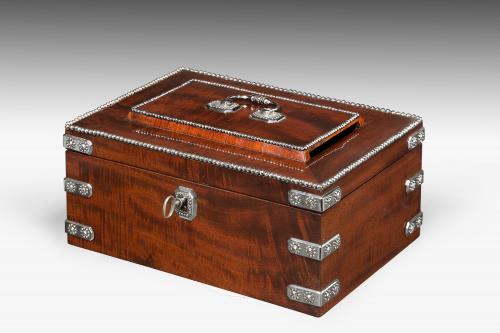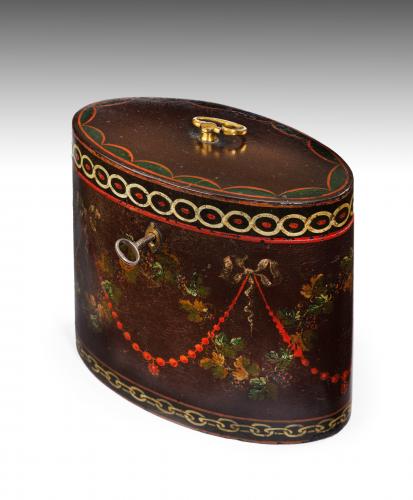
Price on application
This object includes complimentary, Insured Shipping / Delivery within the UK
This object is eligible for a Certificate of BADA Provenance
The BADA Standard
- Since 1918, BADA has been the leading association for the antiques and fine art trade
- Members are elected for their knowledge, integrity and quality of stock
- Our clients are protected by BADA’s code of conduct
- Our dealers’ membership is reviewed and renewed annually
- Bada.org is a non-profit site: clients deal directly with members and they pay no hidden fees
Chinese Export Black Lacquer and Gilt Pagoda with original silk-lined leather case.
China, Circa 1790.
Provenance:
Private Collection, Paris.
Jeremy Ltd., London, 1991.
Comprised of seven separate graduated wooden boxes with black, red, green and gilt lacquer decoration depicting Chinese garden landscapes, vases of flowers and mythical figures on the base, with original gilt tooled leather case of European origin retaining the original silk lining.
Pagodas were a regular motif on items created in China for export in the 18th and 19th centuries. Models of pagodas and items in that form were sought after in the west by wealthy clients and were created in a wide range of materials including ceramic, enamel, papier-mâché, stone, ivory and precious metals. As a symbol of the ‘exotic’, they were popularised in prints of drawings in Europe from the 17th century onwards; for example ‘China Illustrata’ (1667) by Athanasius Kircher and ‘Geographical, Historical, Chronological, Political, and Physical Description of the Empire of China and Chinese Tartary’ (1735) by Jean-Baptiste Du Halde. In England, Chinese imagery was popularised by writers such as William Alexander, who made over two thousand sketches during his travels across China including ‘Views of the headlands, islands, etc., taken during a voyage to, and along the eastern coast of China, in the years 1792 & 1793’ (1798) and a collection of etchings entitled ‘Chinese Life’ (1798-1805). Thirteen were exhibited at the Royal Academy between 1795 and 1804.
The Whampoa Pagoda on the Pearl River in Canton (Guangzhou) became a Chinese icon in the west, appearing on anything from oil paintings to ladies’ fans. Built in 1600, the pagoda was an important navigation mark for foreign merchant vessels between Canton and Whampoa. By the Europeans at Canton, the pagoda was known as the Half-way pagoda.
William Chambers (1726-96), who became architect to George III wrote ‘Designs of Chinese Buildings, Furniture, Dresses, Machines and Utensils’ (London 1757) – the earliest technical record of Chinese architecture by a European architect. Chambers designed the Pagoda at Kew which was completed in 1762 as a gift for Princess Augusta.
A number of pagoda models can be found in western museum collections. Between 1806-1816, King George IV bought six porcelain pagodas for the Brighton Pavilion. These and other examples are now in the Royal Collections Trust including examples in ivory (RCIN 32), painted, gilt and enamelled porcelain (RCIN 1) and gilt wood and red lacquer (RCIN 26063). The National Trust Collections also has examples at Blickling Hall (NT 356415), Osterley Park (NT 771739.1). An ivory example which is in the MET Museum was acquired in China by Samuel Shaw, who arrived in the port city of Canton (Guangzhou) in 1784 aboard The Empress of China, the first merchant ship sent there from the newly independent United States (58.73a, b). An example dated circa 1801 is in the collection of the Peabody Essex Museum, Salem, Massachusetts and a large model of a pagoda, decorated in underglaze blue and overglazed polychrome enamels, is in the Victoria and Albert Museum (C.80-1954). Examples with sides painted to imitate brick walls, are in the Rijksmuseum (AK-NM-6935), and the Winterthur Museum, Delaware (1959.3381 A).
Lacquerware was used as a means of decoration for furniture and objects and was much sought after in Europe in the 18th century. Crossman dedicates a chapter to gilt-decorated lacquerware and writes of 18th century Chinese export work ‘Lacquer furniture was of light and rather delicate construction and was most often decorated in black with gold. The forms made…were all copied from western models sent to China or made from designs and plans in English and continental books and catalogues.’ (Carl L. Crossman, ‘The Decorative Arts of the China Trade’, Antique Collectors’ Club, 1991, p. 263-4).
Dimensions
66 x 21 x 21 cmPrice on application
This object includes complimentary, Insured Shipping / Delivery within the UK
This object is eligible for a Certificate of BADA Provenance
Stock number
7040The BADA Standard
- Since 1918, BADA has been the leading association for the antiques and fine art trade
- Members are elected for their knowledge, integrity and quality of stock
- Our clients are protected by BADA’s code of conduct
- Our dealers’ membership is reviewed and renewed annually
- Bada.org is a non-profit site: clients deal directly with members and they pay no hidden fees



